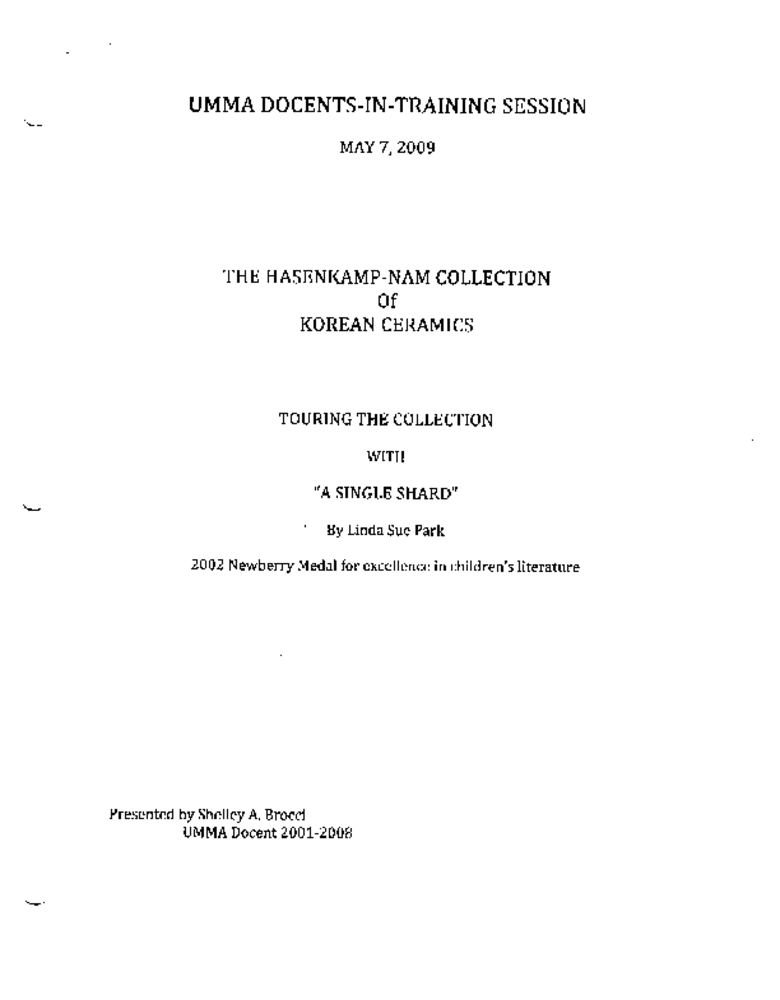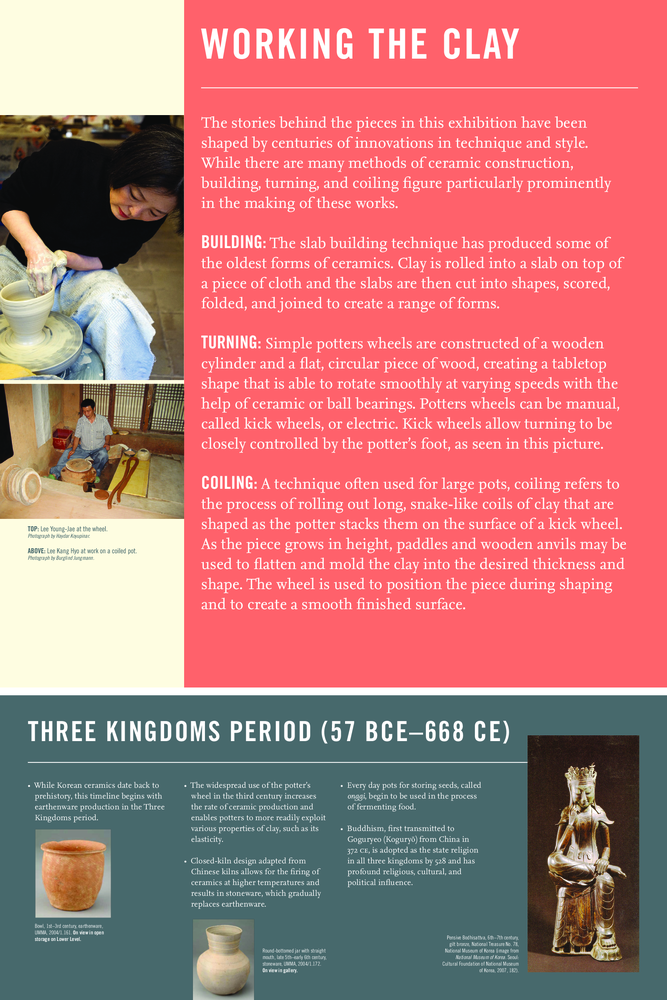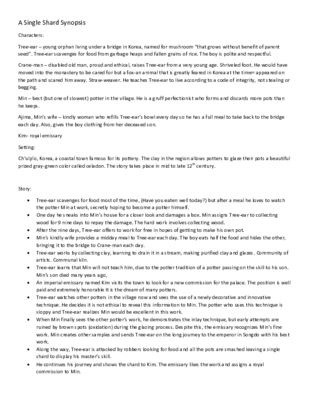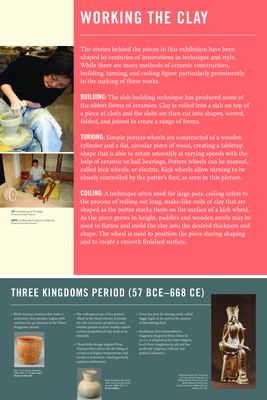Fifth Grade: A Single Shard
Docent Curricular Tour by Shelly Brocci
This tour was originally created by Shelley Brocci (UMMA Docent 2001-2008) to accompany the novel A Single Shard, by Linda Sue Park.
Objectives:
- Provide students with context for the Korean ceramics featured in the novel.
- Discuss the physical and chemical process of throwing and firing ceramics
- Connect collection objects to story to it comes to life
- Incorporate a drawing session to allow hands-on experience with simple designs
For a synopsis of the novel, see the attached PDF handout. Students may need to refresh their memory of characters, plot, and theme.
Stop 1: Celadon in Korean Gallery / Focus on story
- Discuss the novel's themes while observing specific celadon pieces. Why were they so prized?
Talking Points:
- Flattened Bottle with Lion Head: rarity, unglazed gray stoneware in contrast with celadon, identify animals because no lions in Korea, Silk Road trading route
- Large pedestal bowl on stand: note natural ash glaze. Wood ash contains potash, potassium compounds; when they melt they become vitreous.
- Lotus-shaped cup and stand: lotus is Buddhist symbol of purity; source of images is nature. Does this fit the description of rare celadon?
- Roof tiles Prop: What impressed tree-ear about the palace roof? What does it tell you about the country that the ruler has such precious ceramics on his roof? What do tiles do?
Stop 2: Ceramics in basement open storage / Focus on chemical process
- Rust-colored cup: the clay contains iron; heated in oxygen-rich kiln, it becomes iron oxide (rust). How was it made? Coil on slow wheel; sides smoothed with paddle.
Discuss the chemistry that occurs when the ceramics and glaze oxidizes. When the temp in the climbing kiln gets real hot, the openings are closed, cutting down on the amount of oxygen in the kiln (reducing). The iron in the glaze then loses some of its oxygen to form some iron substances (ions) that have a yellow [ferric] or blue [feffous] color. So where does the green come from? Blue plus yellow. Color of the glaze depends on the thickness of the glaze, the type of clay, and the type of kiln and temperature; amount of oxygen, position of pots in kiln.
- Discuss the firing process and how a kiln works
Stop 3: Buddhist Gallery / Focus on context and religion
- Temple bell? How did he happen to grow up in Chulpo?
- Focus on the Buddhist elements in the story such as giving to the poor, meditating, living in a monastery
Stop 4: Ten-Fold Screen / Focus on natural imagery
- Photo of the Cliff of the Thousand Flowers. Korea is similar to Michigan in climate. How is this similar to Chinese scrolls? Conventions of Asian landscapes.
Stop 5: Drawing
- Some docents like to include a hands-on activity for students, to draw a natural form, as Tree Ear would have done.
General Celadon Questions:
- Is all celadon the same color? No. Shades vary. How does Emissary Kim describe the best shade?
- What sometimes appeared on celadon that wasn't wanted? Hint: Potter Min smashed his work. Brown spots
- What firing factors affect the color of celadon? Length of firing, position in the kiln, number of pieces in the kiln, too much air in the kiln.
- What mineral is in the clay that gives it its special color when fired? What color does it turn when fired? Iron. Varying shades of green after firing.
- What was the inspiration for the shapes that you see? Nature. Melons, boards, leaves, stems
- How were the leaves and stems created? Tree ear did this in secret. Molded.
Part of 2 Learning Collections
<p>Docent Curricular Tour</p>
<p>From Jennifer Friess, Docent CE on March 12, 201...
Rate this Resource
AVG: 0 | Ratings: 0
& Author Notes
Creative Commons by-nc-sa (Docent Shelly Brocci authored the text and attached document)Last Updated
January 28, 2020 6:06 a.m.Report
Reporting Policy

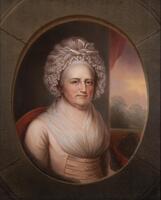
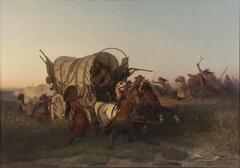
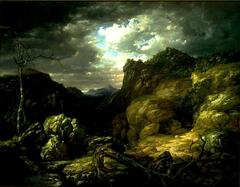
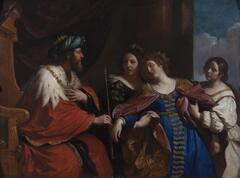

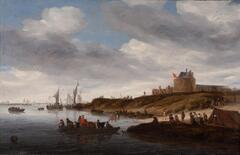

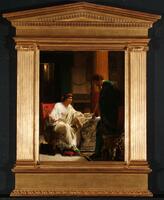
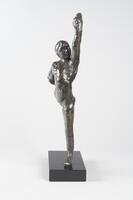
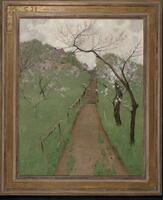
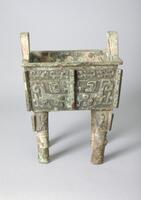
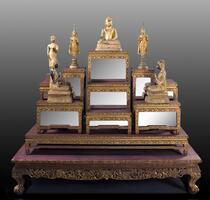
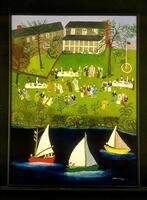
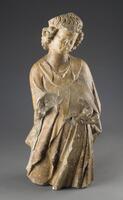
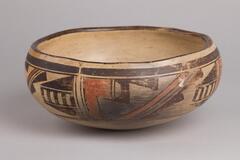
![<p>This celadon bowl is decorated with mold-impressed designs, which was one of popular type of dishes in 11th and 12th centuries. On its inner walls are lotus scroll designs, and on its inner base is what is presumed to be a lotus flower design. Glaze has been applied all the way down to the rim of the foot, which retains traces of silica supports in three places. The yellow-green glaze is evenly spread on the surface, while the clay is of specially selected high quality, producing a smooth surface.<br />
[<em>Korean Collection, University of Michigan Museum of Art</em> (2014) p.111]</p>
<br />
shallow lobed bowl with molded lotus design on wall, 6 lobes, very small foot, high quality, need cleaning <p>This celadon bowl is decorated with mold-impressed designs, which was one of popular type of dishes in 11th and 12th centuries. On its inner walls are lotus scroll designs, and on its inner base is what is presumed to be a lotus flower design. Glaze has been applied all the way down to the rim of the foot, which retains traces of silica supports in three places. The yellow-green glaze is evenly spread on the surface, while the clay is of specially selected high quality, producing a smooth surface.<br />
[<em>Korean Collection, University of Michigan Museum of Art</em> (2014) p.111]</p>
<br />
shallow lobed bowl with molded lotus design on wall, 6 lobes, very small foot, high quality, need cleaning](/media/W1siZiIsIjIwMjIvMDkvMjQvMmx1M2ptNHMzM19kZWZhdWx0LmpwZyJdLFsicCIsInRodW1iIiwiMjQweDIwMCJdXQ?sha=2ba2ecc35e4531c3)
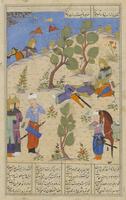
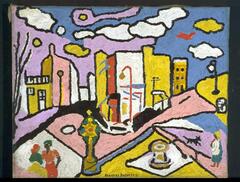
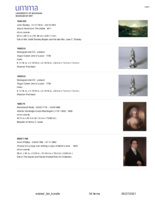
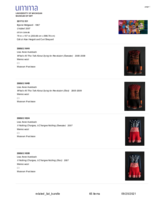
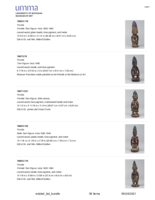


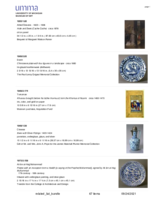
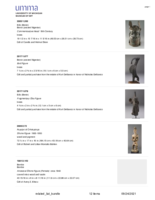
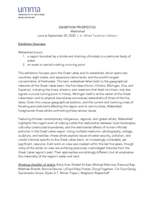

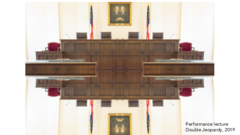
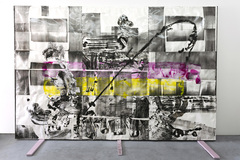



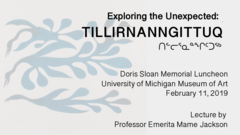
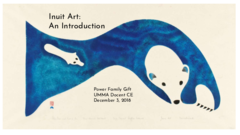
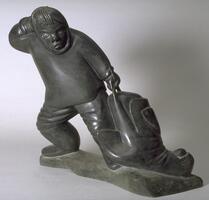

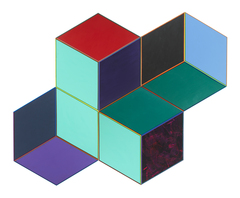
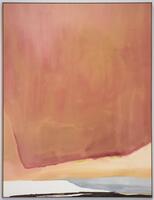




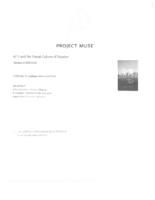
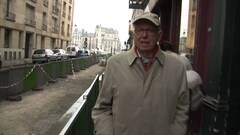


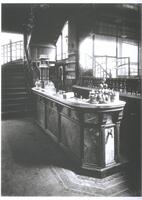
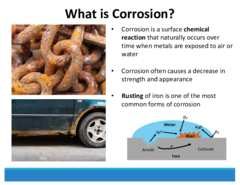
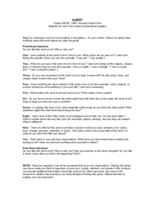

![<p>This celadon bowl is decorated with mold-impressed designs, which was one of popular type of dishes in 11th and 12th centuries. On its inner walls are lotus scroll designs, and on its inner base is what is presumed to be a lotus flower design. Glaze has been applied all the way down to the rim of the foot, which retains traces of silica supports in three places. The yellow-green glaze is evenly spread on the surface, while the clay is of specially selected high quality, producing a smooth surface.<br />
[<em>Korean Collection, University of Michigan Museum of Art</em> (2014) p.111]</p>
<br />
shallow lobed bowl with molded lotus design on wall, 6 lobes, very small foot, high quality, need cleaning <p>This celadon bowl is decorated with mold-impressed designs, which was one of popular type of dishes in 11th and 12th centuries. On its inner walls are lotus scroll designs, and on its inner base is what is presumed to be a lotus flower design. Glaze has been applied all the way down to the rim of the foot, which retains traces of silica supports in three places. The yellow-green glaze is evenly spread on the surface, while the clay is of specially selected high quality, producing a smooth surface.<br />
[<em>Korean Collection, University of Michigan Museum of Art</em> (2014) p.111]</p>
<br />
shallow lobed bowl with molded lotus design on wall, 6 lobes, very small foot, high quality, need cleaning](/media/W1siZiIsIjIwMjIvMDkvMjQvMmx1M2ptNHMzM19kZWZhdWx0LmpwZyJdLFsicCIsInRodW1iIiwiMTAwMHgxMDAwIl1d?sha=cf3e69ebc125e88e)
![<p>The bowl has a low, narrow foot, and diagonally aring out sides. It is decorated with raised designs on the inner wall, but they are so low relief that it is di cult to recognize what they are. The outer base retains three quartzite spur marks. Damage to a side of the mouth rim and the center of the bowl has been repaired.<br />
[<em>Korean Collection, University of Michigan Museum of Art </em>(2014) p.99]</p>
It flares out widely at the rim, then back in. Its sides, otherwise almost straight, taper to the base. There is no decorated. <p>The bowl has a low, narrow foot, and diagonally aring out sides. It is decorated with raised designs on the inner wall, but they are so low relief that it is di cult to recognize what they are. The outer base retains three quartzite spur marks. Damage to a side of the mouth rim and the center of the bowl has been repaired.<br />
[<em>Korean Collection, University of Michigan Museum of Art </em>(2014) p.99]</p>
It flares out widely at the rim, then back in. Its sides, otherwise almost straight, taper to the base. There is no decorated.](/media/W1siZiIsIjIwMjIvMDUvMjUvN2U2NG9zYmNkcV9kZWZhdWx0LmpwZyJdLFsicCIsInRodW1iIiwiMTAwMHgxMDAwIl1d?sha=95b247e15d1b7bb2)

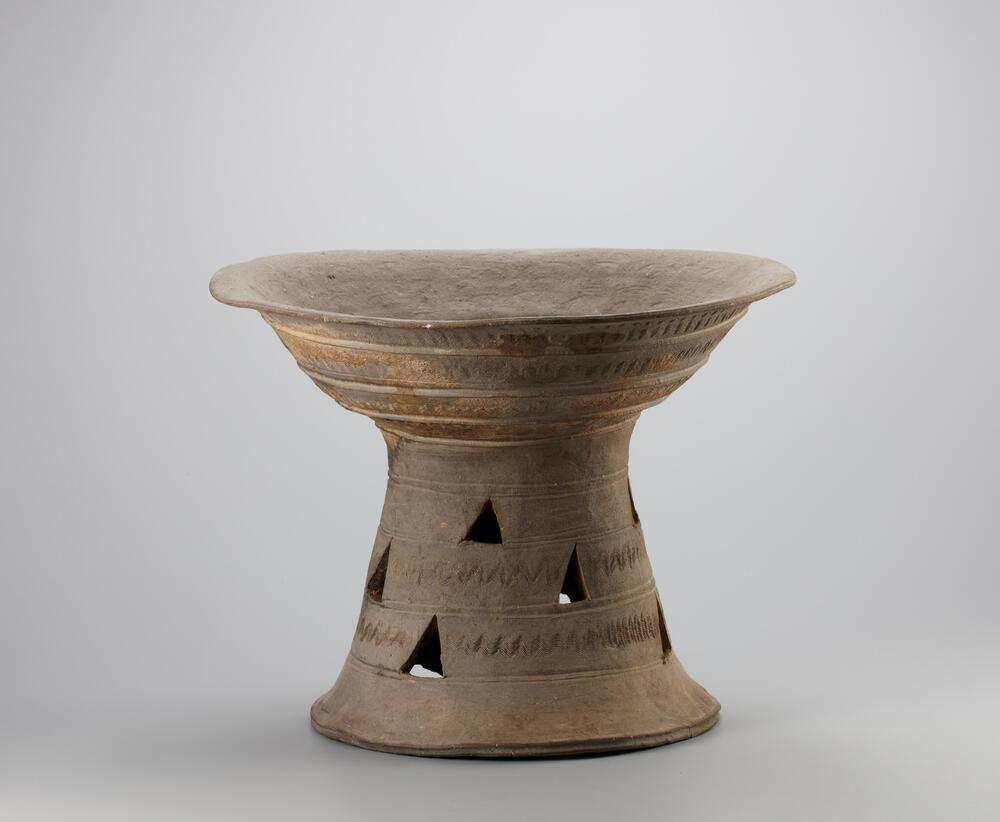
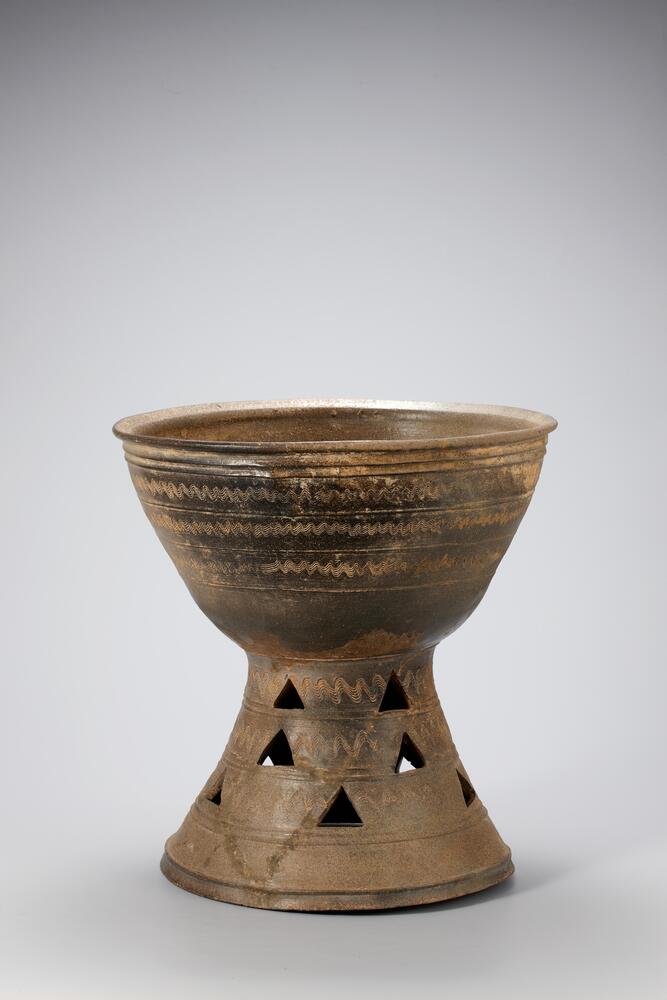
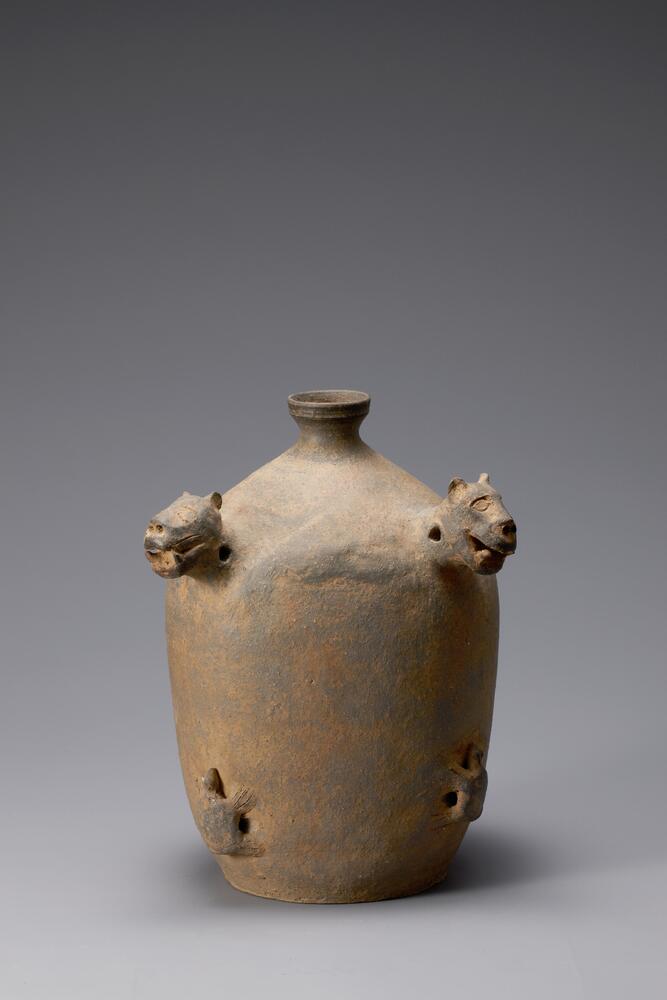
![Stoneware ewer with celadon glaze in the shape of a calabash, or double-gourd. The handle mimics the tendrils of the gourd. A long, thin spout curves slightly outward from the rounded base, and a small lid crested by a tendril-like loop covers an opening at the top of the ewer.
<p>This is an undecorated gould-shaped ewer. Its stopper, handle joints, handle, and spout show traces of repair and restoration. The at base retains four refractory spur marks and was glazed only in the center of the outer base. The glaze was not fused well in parts, leaving some runnings, but it is well balanced in form.<br />
[<em>Korean Collection, University of Michigan Museum of Art </em>(2014) p.132]</p>
Stoneware ewer with celadon glaze in the shape of a calabash, or double-gourd. The handle mimics the tendrils of the gourd. A long, thin spout curves slightly outward from the rounded base, and a small lid crested by a tendril-like loop covers an opening at the top of the ewer.
<p>This is an undecorated gould-shaped ewer. Its stopper, handle joints, handle, and spout show traces of repair and restoration. The at base retains four refractory spur marks and was glazed only in the center of the outer base. The glaze was not fused well in parts, leaving some runnings, but it is well balanced in form.<br />
[<em>Korean Collection, University of Michigan Museum of Art </em>(2014) p.132]</p>](/media/W1siZiIsIjIwMjIvMDkvMjQvMzhtcnlydW44Ml9kZWZhdWx0LmpwZyJdLFsicCIsInRodW1iIiwiMTAwMHgxMDAwIl1d?sha=e312f3ef73fb071c)
![<p>Despite some glaze runnings, this high-quality vessel serves as a ne example of the 12th and 13th century celadon that features a good quality of clay body, glazed surface and glaze color. Its outer rim has a fret-patterned band,and on the outer wall are inlaid peony spray designs in three places. The mouth rim curves inwards slightly. The foot is low and has traces of silica spur, as well as cracks in two places.<br />
[<em>Korean Collection, University of Michigan Museum of Art </em>(2014) p.119]<br />
</p>
Rounded tea bowl with celadon glaze. A lightly incised peony design is spaced along the widest stretch of the cup, and below the rim is an incised fret pattern. <p>Despite some glaze runnings, this high-quality vessel serves as a ne example of the 12th and 13th century celadon that features a good quality of clay body, glazed surface and glaze color. Its outer rim has a fret-patterned band,and on the outer wall are inlaid peony spray designs in three places. The mouth rim curves inwards slightly. The foot is low and has traces of silica spur, as well as cracks in two places.<br />
[<em>Korean Collection, University of Michigan Museum of Art </em>(2014) p.119]<br />
</p>
Rounded tea bowl with celadon glaze. A lightly incised peony design is spaced along the widest stretch of the cup, and below the rim is an incised fret pattern.](/media/W1siZiIsIjIwMjIvMDkvMjQvbTVxdXo2eng4X2RlZmF1bHQuanBnIl0sWyJwIiwidGh1bWIiLCIxMDAweDEwMDAiXV0?sha=4dd3c0a98da2e6ef)

